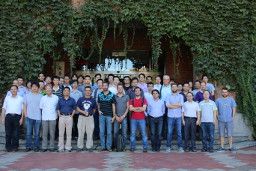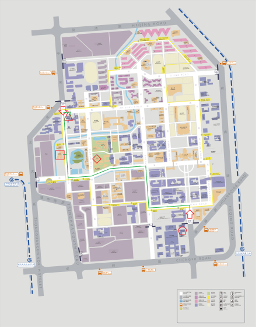8-th Beijing Geometry and Physics Colloquium
Workshop on Gromov-Witten Theory and Integrable Hierarchies
Sep 25 - 27, 2015. Room A304, Department of Mathematics, Tsinghua University, P. R. China.
As a part of Beijing Geometry and Physics Colloquium, we organize this weekend workshop on Gromov-Witten Theory and Integrable Hierarchies. The relation between Gromov-Witten type theory and integrable hierarchies has been a long standing problem in both area. The workshop aims to bring the top experts together to exchange idea and make further progress.
Schedule
Sep 25 (Friday)
13:50 ~ 14:00, Opening
14:00 ~ 15:00, Boris Dubrovin (SISSA)
Title: On Witten-Kontsevich tau-function and its generalisations
Abstract: A simple procedure for computing logarithmic derivatives of tau-function of any solution to the KdV hierarchy will be presented. As an application one obtains an efficient algorithm for computation of the intersection numbers of psi-classes on the moduli spaces of stable algebraic curves of an arbitrary genus. A generalisation of the above construction to an arbitrary simple Lie algebra will also be given. The talk is based on a joint work with Marco Bertola and Di Yang.
15:00 ~ 15:15, Tea Break
15:15 ~ 16:15, Si-Qi Liu (Tsinghua University)
Title: Construction of Tau Functions for Bihamiltonian Integrable Hierarchies
Abstract: In Dubrovin-Zhang's axiomatic construction, the bihamiltonian structure and tau functions of an integrable hierarchy play crucial roles. On the other hand, a bihamiltonian integrable hierarchy may not possess tau functions (for example, the Camassa-Holm hierarchy). What kind of bihamiltonian integrable hierarchy can have tau functions, and how to construct them are two important problems in Dubrovin-Zhang's construction. In this talk, I will introduce our recent results for these problems. This is a joint work with Boris Dubrovin and Youjin Zhang.
(Note: there is another wonderful lecture given by Prof. Philip Candelas at 16:30, Lecture hall, Floor 3, Jinchunyuan West Building. See here for details.)
Sep 26 (Saturday)
09:00 ~ 10:00, Bertrand Eynard (IPHT/CEA/Saclay and CRM Montreal)
Title: Topological Recursion and Gromov-Witten Theory
Abstract: Topological recursion (TR) is a universal recursion relation first discovered in the context of random matrices, but which also appears in many other enumerative problems, including Hurwitz numbers, Mirzakhani's volumes, Jones polynomials, and Gromov-Witten invariants, etc... and makes it amazingly ubiquitous. Reversing the point of view, one can use TR as a (computational) definition of invariants of a "spectral curve" (a locally plane analytic curve, used as initial term in the recursion). It was recently proved [EO 2012, FLT 2013] that Gromov-Witten invariants of toric CY3-folds are the TR invariants of the mirror. The proof relies on the link between TR and the Givental's formalism. In this talk, I will introduce TR, the link to Givental formalism, and discuss some beautiful properties of TR invariants.
10:00 ~ 10:30, Tea Break
10:30 ~ 11:30, Todor Milanov (IPMU)
Title: Vertex Algebras and Gromov-Witten Invariants
Abstract: I will report the current progress in my joint project with B. Bakalov. The main goal is to obtain a reconstruction of the higher-genus GW invariants of a compact Kahler orbifold with semi-simple quantum cohomology in terms of the monodromy data of the Frobenius manifold corresponding to quantum cohomology.
11:30 ~ 13:30, Lunch Break
13:30 ~ 14:30, Qingping Liu (CUMTB)
Title: Conservation Laws and Symmetries of Hunter-Saxton equation
Abstract: Through a reciprocal transformation $\mathcal{T}_0$ induced by the conservation law $\partial_t(u_x^2) = \partial_x(2uu_x^2)$, the Hunter-Saxton (HS) equation $u_{xt} = 2uu_{2x} + u_x^2$ is shown to possess conserved densities involving arbitrary smooth functions, which have their roots in infinitesimal symmetries of $w_t = w^2$, the counterpart of the HS equation under $\mathcal{T}_0$. Hierarchies of commuting symmetries of the HS equation are studied under appropriate changes of variables initiated by $\mathcal{T}_0$, and two of these are linearized while the other is identical to the hierarchy of commuting symmetries admitted by the potential modified Korteweg-de Vries equation. A fifth order symmetry of the HS equation is endowed with a sixth order hereditary recursion operator by its connection with the Fordy-Gibbons equation. These results reveal the origin for the rich and remarkable structures of the HS equation and partially answer the questions raised by Wang [NL 23 (2010)].
14:30 ~ 15:00, Tea Break
15:00 ~ 16:00, Guido Carlet (Universiteit van Amsterdam)
Title: The Deformations of Semisimple Poisson Pencils of Dubrovin-Novikov Type are Unobstructed: Spectral Sequences in the Computation of Bihamiltonian Cohomology Groups
Abstract: It is well known that the obstructions to the extension of infinitesimal deformations to full ones, in the deformation theory of compatible pairs of Poisson brackets of Dubrovin-Novikov type, are given by the third bihamiltonian cohomology group. In this talk we review our recent result with H. Posthuma and S. Shadrin on the vanishing of the bihamiltonian cohomology a semisimple Poisson pencil of Dubrovin-Novikov type using spectral sequences.
16:00 ~ 16:30, Tea Break
16:30 ~ 17:30, Paolo Rossi (Universite de Bourgogne 9)
Title: Double Ramification Hierarchies
Abstract: In a series of joint papers with Alexandr Buryak (and more recently also with B. Dubrovin and J. Guéré) we studied the double ramification (DR) hierarchy, a new way, devised by A. Buryak, of associating an integrable system of Hamiltonian PDEs to a cohomological field theory (CohFT), which makes explicit use of Hodge classes and, more importantly, the intersection theory of the double ramification cycle. The DR cycle is the locus, in the moduli space of curves, of stable Riemann surfaces whose marked points support a principal divisor. While the DR hierarchy coincides with the Dubrovin-Zhang (DZ) hierarchy in genus 0, it is a priori completely independent in higher genera. A. Buryak has however conjectured that the two hierarchies are in fact equivalent via change of coordinates in the phase space. We have computed several examples of DR hierarchies (trivial, $r$-spin, Hodge CohFTs, GW theory of $\mathbb{CP}^1$ and all target varieties with non-positive first Chern class, including all Calabi-Yau's), extended the definition to include partial CohFTs, found recursion relations for descendants in all genera and found a very explicit quantization construction. In several cases (KdV, Toda, ILW, Gelfand-Dickey and more) we proved the DR/DZ equivalence conjecture. I will report on (a part of) these findings.
18:00 ~ 20:00, Banquet (Jiasuo Guesthouse)
Sep 27 (Sunday)
09:00 ~ 10:00, Andrea Brini (Universite de Montpellier 2)
Title: Crepant Resolutions and Integrable Systems
Abstract: A famous conjecture due to Yongbin Ruan, and subsequently expanded in works of Coates-Iritani-Tseng, Iritani and Coates-Iritani, states that the quantum cohomology algebras of two complex algebraic varieties (or orbifolds) in a crepant birational relationship should be suitably related upon analytic continuation of the quantum parameters. I will discuss a surprising connection with integrable systems of a class of targets with equivariantly semi-simple quantum cohomology, including hard Lefschetz toric CY3-orbifolds and ADE surface singularities, and discuss how this knowledge may be used to offer a proof of the all-genus Crepant Resolution Conjecture with descendents for these targets. This is based on works with Cavalieri-Ross, Carlet-Romano-Rossi, and ongoing solo-work by the speaker.
10:00 ~ 10:30, Tea Break
10:30 ~ 11:30, Di Yang (SISSA)
Title: On the Dubrovin-Zhang-Hodge Integrable Hierarchy
Abstract: This is a joint work with Boris Dubrovin, Si-Qi Liu and Youjin Zhang. For any semisimple Frobenius manifold, we construct a tau-symmetric integrable hierarchy of Hamiltonian PDEs, called the Dubrovin-Zhang-Hodge hierarchy, such that the total Hodge potential defined by Givental is a particular tau function of this hierarchy. For the one-dimensional Frobenius manifold, we conjecture that the Dubrovin-Zhang-Hodge hierarchy is a universal object in all tau-symmetric Hamiltonian scalar PDEs.

Scientific Committee
Yongbin Ruan
Youjin Zhang
Organizing Committee
Si-Qi Liu
Yongbin Ruan
Youjin Zhang
Invited Speakers
Andrea Brini
Guido Carlet
Boris Dubrovin
Bertrand Eynard
Qingping Liu
Si-Qi Liu
Todor Milanov
Paolo Rossi
Di Yang
Contact
Si-Qi LiuPhone: (+86) 010-62798021
Email: liusq@tsinghua.edu.cn Xinpai Chen
Phone: (+86) 010-62772984
Email: xpchen@math.tsinghua.edu.cn
Accommodation
Jinchunyuan HotelPhone: (+86) 010-62784008
Jiasuo Guesthouse
Phone: (+86) 010-62783166
Unis Center
Phone: (+86) 010-62791888
Homepage: http://www.uniscenter.com/
Map

 Department of Mathematics
Department of Mathematics
 Jinchunyuan Hotel
Jinchunyuan Hotel
 Jiasuo Guesthouse
Jiasuo Guesthouse
 Unis Center
Unis Center
 Main Gate
Main Gate
 Northwest Gate
Northwest Gate
 Taxi Route
Taxi Route